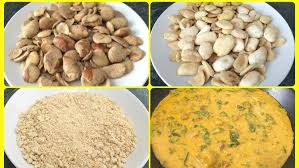Ogbono seeds in cooking are an essential ingredient in many West African dishes, particularly in Nigeria. Known for their unique thickening properties, these seeds come from the wild mango tree (Irvingia gabonensis). Ogbono seeds are typically ground into powder and used to prepare rich, flavorful soups and stews.
The seeds have a slightly earthy, nutty taste, and when cooked, they create a smooth, viscous texture that sets them apart from other thickening agents. They are particularly popular in dishes such as Ogbono soup, a traditional meal enjoyed by various ethnic groups in Nigeria.
The use of Ogbono seeds in cooking provides more than just flavor and texture. These seeds are packed with essential nutrients like healthy fats, fiber, and protein, making them a nutritious addition to any diet. Rich in antioxidants, they offer several health benefits, including improved heart health and digestion. Because of their versatility, Ogbono seeds can be combined with a variety of ingredients like meat, fish, vegetables, and leafy greens to create wholesome meals that are both filling and flavorful.
To cook with Ogbono seeds, the process generally begins by roasting or drying the seeds, which are then ground into a fine powder. The powdered Ogbono is mixed into a broth or soup base, where it thickens upon simmering.
The soup is usually enriched with palm oil, spices, and seasonings, giving it a vibrant color and deep taste. Depending on regional preferences, ingredients like goat meat, fish, or stockfish are often added to the soup, along with vegetables such as bitter leaf or spinach for extra flavor and nutrition.
One of the key factors to remember when cooking with Ogbono seeds is the method of adding the ground seeds to the dish. If added too early or at a high temperature, the thickening effect may reduce, resulting in a thinner soup. Thus, the ground seeds are usually stirred in after the meat or fish is partially cooked, allowing the seeds to gradually release their thickening agents as they simmer. This technique ensures that the soup achieves the desired consistency without losing the traditional texture Ogbono is known for.
In addition to soups, Ogbono seeds can also be used in other creative ways, such as in sauces or to thicken vegetable stews. Their thickening property makes them a great alternative to cornstarch or flour in recipes that require a smooth, consistent texture. As more people explore African cuisine, Ogbono seeds have gained popularity for their ability to enhance the texture of a variety of dishes.
Whether you are preparing a traditional Nigerian Ogbono soup or experimenting with new recipes, Ogbono seeds offer a delightful and nutritious way to add flavor and texture to your meals. With their rich cultural significance and versatility in cooking, these seeds continue to be a cherished staple in many kitchens across West Africa.
Nutritional Benefits of Ogbono Seeds

1. Rich in Healthy Fats: Ogbono seeds contain high levels of healthy fats, particularly omega-3 fatty acids, which are beneficial for heart health and brain function.
2. High in Fiber: The seeds are a good source of dietary fiber, aiding digestion, promoting gut health, and helping in weight management.
3. Packed with Protein: Ogbono seeds offer plant-based protein, supporting muscle growth and repair, making them a great option for vegetarians.
4. Contains Essential Minerals: Ogbono seeds are rich in essential minerals such as calcium, magnesium, potassium, and iron, which support bone health, muscle function, and energy production.
5. Antioxidant Properties: They are high in antioxidants, which help protect the body from oxidative stress and inflammation, supporting overall health and immunity.
Selecting Quality Ogbono Seeds for Cooking
1. Look for Freshness: Fresh Ogbono seeds have a light, oily texture and a distinct aroma. Avoid seeds that are too dry or lack aroma.
2. Check for Uniform Color: Quality Ogbono seeds should have a uniform brownish color without signs of discoloration, mold, or damage.
3. Avoid Contamination: Ensure the seeds are free from debris, stones, or any foreign particles that may affect the taste and texture during cooking.
4. Buy from Trusted Sources: Purchase Ogbono seeds from reliable suppliers or markets to ensure they are fresh, unadulterated, and of high quality.
5. Opt for Whole Seeds: Whole seeds retain more flavor and nutrients compared to pre-ground Ogbono, allowing for better control over the cooking process.
Preparing Ogbono Seeds for Cooking
1. Clean the Seeds: Start by cleaning the seeds to remove any dirt or debris by rinsing them under cold water or sifting through them manually.
2. Sun Dry for Grinding: If the seeds are moist or fresh, sun-dry them to make them easier to grind. Spread the seeds in a single layer and dry them for a few hours.
3. Grind into Powder: Use a food processor, blender, or traditional mortar and pestle to grind the dried seeds into a fine powder, which is essential for most Ogbono recipes.
4. Store Properly: After grinding, store the Ogbono powder in an airtight container in a cool, dry place to maintain freshness for cooking.
5. Rehydrate Before Use: Some recipes require soaking or rehydrating the Ogbono powder in warm water for a few minutes before adding it to soups or stews to thicken the dish.
How to Grind Ogbono Seeds for Soup
1. Clean the Seeds: Begin by cleaning the Ogbono seeds to remove any dirt or debris, using cold water or manually sifting them.
2. Sun-Dry the Seeds: If the seeds are moist, spread them in a single layer and sun-dry for several hours until fully dry to make grinding easier.
3. Use a Grinder or Blender: Place the dried seeds in a food processor, coffee grinder, or blender and grind until you achieve a smooth, fine powder.
4. Sift the Powder: For an extra smooth texture, sift the powder to remove any larger particles that may not have ground properly.
5. Store in an Airtight Container: Store the ground Ogbono in a cool, dry place in an airtight container to maintain its freshness for cooking.
Cooking Ogbono Soup: A Step-by-Step Guide
1. Heat Palm Oil: Start by heating palm oil in a pot over medium heat until it melts and becomes translucent.
2. Add Ground Ogbono: Stir in the ground Ogbono powder and cook it in the oil, stirring constantly until it dissolves and becomes stretchy.
3. Add Meat or Fish Stock: Slowly pour in meat or fish stock, stirring to combine the Ogbono with the stock, and let it simmer for 10-15 minutes.
4. Season the Soup: Add seasonings such as salt, pepper, crayfish, and season cubes to taste, ensuring the flavors blend well with the Ogbono.
5. Add Protein and Vegetables: Stir in your cooked meat, fish, or shrimp, along with optional vegetables like spinach or bitter leaves, and allow the soup to simmer for a few more minutes.
6. Serve Hot: Once the soup has thickened and the ingredients are fully cooked, remove it from the heat and serve hot with fufu, pounded yam, or rice.
Read Also: 22 Medicinal Health Benefits of Nutmeg (Myristica Fragrans)
Adding Ogbono Seeds to Stews

1. Prepare the Ogbono Powder: Clean and grind the Ogbono seeds into a fine powder as described above.
2. Add to the Stew Base: After your stew base (usually a mix of tomatoes, peppers, and onions) is fully cooked, gradually stir in the ground Ogbono.
3. Allow It to Thicken: As the Ogbono absorbs the liquid in the stew, it will thicken the mixture. Let it cook for an additional 10-15 minutes to achieve the desired consistency.
4. Add Meat and Vegetables: Stir in any cooked meat, fish, or vegetables and simmer for a few more minutes to allow the flavors to blend.
5. Adjust Seasoning: Taste the stew and adjust the seasoning as necessary before serving with your preferred side dish.
How to Thicken Soups with Ogbono Seeds
1. Prepare Ground Ogbono: Clean and grind the Ogbono seeds into a fine powder, ensuring it is ready to use.
2. Add Directly to Soup: When your soup is almost ready, sprinkle the ground Ogbono powder into the pot while stirring continuously to prevent clumping.
3. Stir to Dissolve: Keep stirring until the Ogbono fully dissolves into the soup and begins to thicken it, which usually takes about 10 minutes.
4. Adjust Thickness: If the soup becomes too thick, you can add more water or stock to reach the desired consistency.
5. Cook for a Few More Minutes: Let the soup simmer for an additional 5-10 minutes to ensure the Ogbono is well incorporated and the flavors meld together before serving.
Enhancing Flavor with Ogbono Seeds
1. Toast the Seeds Before Grinding: Lightly toasting the Ogbono seeds before grinding can enhance their nutty flavor, making the dish more flavorful.
2. Add Spices and Herbs: When using Ogbono in soups or stews, include traditional spices like crayfish, uziza seeds, or locust beans to bring out a rich, complex taste.
3. Use Meat or Fish Stock: Replace plain water with meat or fish stock to intensify the flavor of the Ogbono soup, making it more savory.
4. Pair with Aromatics: Add ingredients like onions, garlic, or ginger to the base of your soup or stew before incorporating Ogbono to deepen the flavor profile.
5. Let It Simmer Slowly: Allow your Ogbono-based dish to simmer slowly over low heat so the flavors have time to meld and develop fully.
Read Also: 13 Medicinal Health Benefits of Chimaphila umbellata (Pipsissewa)
Traditional Nigerian Dishes Using Ogbono Seeds

1. Ogbono Soup: A thick, savory Nigerian soup made with ground Ogbono seeds, palm oil, meat (goat, beef), or fish, often served with pounded yam or fufu.
2. Ogbono Stew: A variation of stew that incorporates Ogbono powder to thicken and enhance the flavor, typically cooked with tomatoes, peppers, and onions.
3. Mixed Ogbono and Egusi Soup: A combination of ground Ogbono and egusi seeds in one dish, providing a rich, textured soup that combines the stretchiness of Ogbono with the earthiness of egusi.
4. Ogbono Okra Soup: A mixture of Ogbono and chopped okra to create a stretchy, slimy soup, perfect for eating with eba, amala, or pounded yam.
5. Ogbono Leaf Soup: A variant that includes traditional leafy greens like bitterleaf or ugu (pumpkin leaves), combined with Ogbono for added texture and flavor.
Storing Ogbono Seeds for Future Use
1. Keep in Airtight Containers: After grinding, store Ogbono powder in an airtight container to prevent moisture and air from affecting its quality.
2. Store in a Cool, Dry Place: To preserve freshness, keep the seeds or powder in a cool, dry location away from sunlight, as heat can degrade the flavor.
3. Refrigeration Option: For longer storage, place the Ogbono seeds or powder in the refrigerator, which can extend its shelf life without losing flavor.
4. Freeze for Extended Storage: If you want to keep Ogbono for a long time, freezing the ground powder in a freezer-safe container can keep it fresh for several months.
5. Avoid Exposure to Humidity: Ensure the storage area is free from humidity, as moisture can cause the Ogbono seeds to clump and spoil quickly.
Common Mistakes to Avoid When Cooking with Ogbono Seeds
1. Not Stirring Continuously: Failure to stir the Ogbono properly when adding it to the soup can result in clumps, making it unevenly distributed.
2. Adding Too Much Water: Adding excess water can make the Ogbono soup too runny, losing the desired thick consistency.
3. Cooking on High Heat: Cooking Ogbono on high heat can burn it quickly and ruin the flavor, so always use low or medium heat.
4. Using Stale Ogbono Seeds: Stale or poorly stored Ogbono seeds lose their taste and thickening properties, so always use fresh seeds or powder.
5. Not Adding Enough Stock: Ogbono seeds need adequate stock or liquid to dissolve properly, so not adding enough can result in a dry, lumpy soup.
Do you have any questions, suggestions, or contributions? If so, please feel free to use the comment box below to share your thoughts. We also encourage you to kindly share this information with others who might benefit from it. Since we can’t reach everyone at once, we truly appreciate your help in spreading the word. Thank you so much for your support and for sharing!
Read Also: How To Educate Yourself On Climate Change






